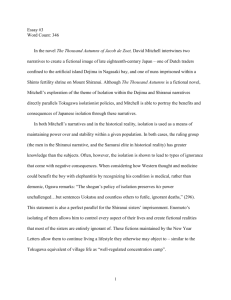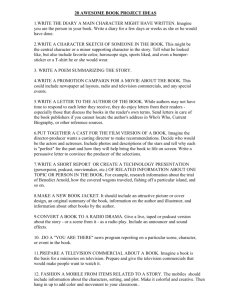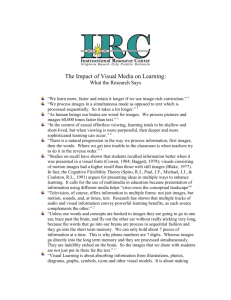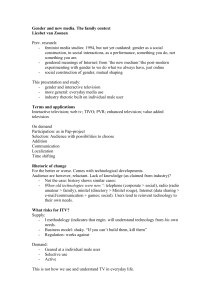PALO FABUŠ Domestification of the World Or Colonisation of Home
advertisement
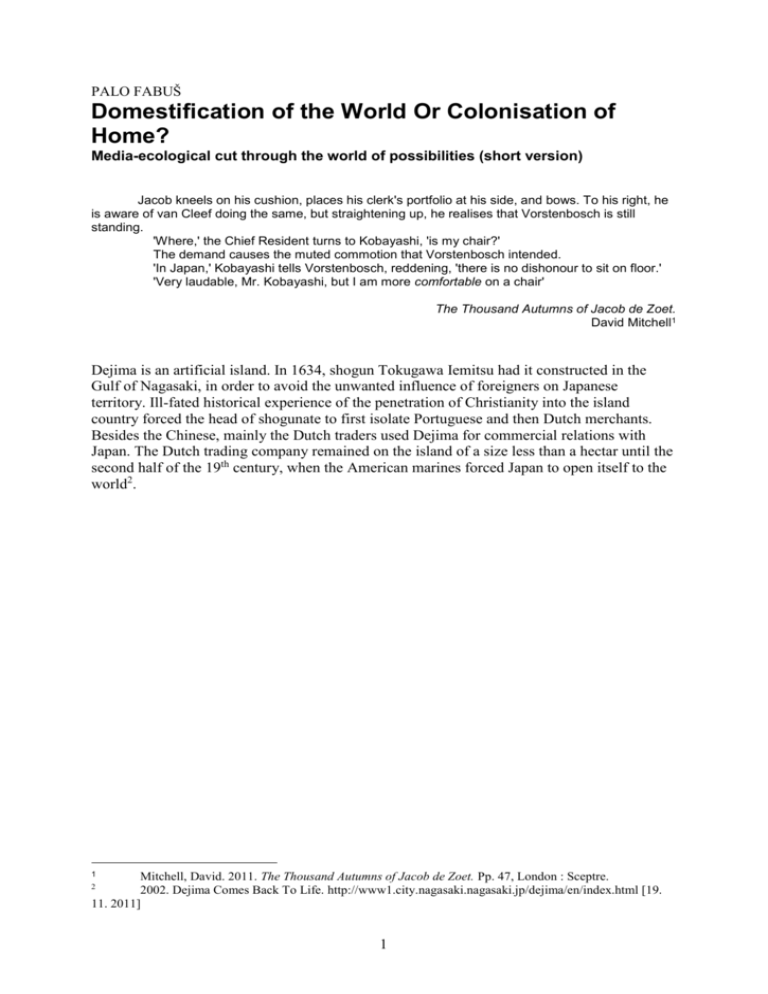
PALO FABUŠ Domestification of the World Or Colonisation of Home? Media-ecological cut through the world of possibilities (short version) Jacob kneels on his cushion, places his clerk's portfolio at his side, and bows. To his right, he is aware of van Cleef doing the same, but straightening up, he realises that Vorstenbosch is still standing. 'Where,' the Chief Resident turns to Kobayashi, 'is my chair?' The demand causes the muted commotion that Vorstenbosch intended. 'In Japan,' Kobayashi tells Vorstenbosch, reddening, 'there is no dishonour to sit on floor.' 'Very laudable, Mr. Kobayashi, but I am more comfortable on a chair' The Thousand Autumns of Jacob de Zoet. David Mitchell1 Dejima is an artificial island. In 1634, shogun Tokugawa Iemitsu had it constructed in the Gulf of Nagasaki, in order to avoid the unwanted influence of foreigners on Japanese territory. Ill-fated historical experience of the penetration of Christianity into the island country forced the head of shogunate to first isolate Portuguese and then Dutch merchants. Besides the Chinese, mainly the Dutch traders used Dejima for commercial relations with Japan. The Dutch trading company remained on the island of a size less than a hectar until the second half of the 19th century, when the American marines forced Japan to open itself to the world2. 1 Mitchell, David. 2011. The Thousand Autumns of Jacob de Zoet. Pp. 47, London : Sceptre. 2002. Dejima Comes Back To Life. http://www1.city.nagasaki.nagasaki.jp/dejima/en/index.html [19. 11. 2011] 2 1 Fig. 1 Dejima. Arnoldus Montanus, 1669. It would seem that the author of the book The Thousand Autumns of Jacob de Zoet David Mitchell chose contact with the Other as a subject of fictive retelling of events from Dejina at the turn of the 18th and 19th century, and that we are reading a story from an exotic setting. But what could be said about the almost three-hundred years old records of Engelbert Kaempfer which served as a source to Michell3, can only be said with quotation marks today. Historical distance enables us to see these events from a different point of view: the British writer captures the beginning of a fundamental change of nothing smaller and nothing more distant from all the exotics, than home. Home is closeness We intuitively understand home as some kind of primary experience, life axiom, which we pointedly leave as young people in order to inadvertently or purposefully discover it over again along with our Self. Even though we do distinguish home and our Self, they have the same root. And this root has one characteristic – it disappears in the flow of life, and it's reestablishing or on the other hand neglecting determines what kind of life we lead. “Everything home is proximate,” claims the Czech philosopher Anna Hogenová. The closeness “makes” home. What we are most, and where we are most is home4. We could be surprised where does home extend to, and how does it reflect in words we say thinking we are “outside”. “Oikos in Greek also means 'home' in a smaller connotation.”5 From oikos, which later gave rise to the prefix eco- like in the word ecology, all ours springs out: home surrounds our life in the smallest events, but as a whole as well. The motive of concern about our environment – which is the motive of ecology – intuitively harmonizes with the concern about our home. Just like ethics, derived from the word ethos, came to life 3 Mitchell, David. 2011. The Thousand Autumns of Jacob de Zoet. Pp. 547, London : Sceptre. Hogenová, Anna. 2000. „K fenomenologii „domova a jinakosti““ [“On Phenomenology of 'Home And Otherness'“]. In: E-Logos r. 2000, ISSN 1211-0442 http://e-logos.vse.cz/index.php?article=222 [5. 7. 2011] 5 ibid. 4 2 by the derivation from the original meaning of the “usual place”, habit, usage. Ethos as a moral aspect of routine, a place where we are shielded from the threats of the Other and the demand for adaptation, suggests a interrelatedness of these notions like birthplace, house, household, ours, one of us, homeland, innate, and therefore also home. However diversely these are articulated in the areas of space, politics, morals, culture and love, forms of closeness always come from home. “There is no place without a here-there difference; that is the primary intuition of human topology. Indeed, perhaps there is no other meaning to the term 'to exist' than to enact this difference“.6 Even though home is neither an object nor an idea, but an entity through which we institute all our relationships to the world7, we often objectify and cover it by different images – often with a candid but mistaken feeling of authenticity. And because each description is always unfair, the first concealment of home already comes with the expression “home” – the price for grasping and using it. Home needs an attention in a sense of keeping the fire as the most important attribute of home. “Because fire contains the most perfect connection of the opposites at all. There is always the flame, which is emerging to appearance, and at the same time the burning wood, going into concealment.” And because “home originates by founding, and not by foundation,”8 it only depends on the character of the effort that we put into our relationship with home, whether we develop our home or we are content with it's fake form – cosiness. 6 Sloterdijk, Peter - Heinrichs, Hans-Jürgen. 2011. Neither Sun Nor Death. Pp. 249, Los Angeles : Semiotext(e). 7 Hogenová, Anna. 2008. „Domov jako problém“ [“Home as a Problem”]In: PAIDEIA, 3-4/V/2008, ISSN 1214-8725. http://userweb.pedf.cuni.cz/paideia/download/hogenovadomov.pdf [5. 7. 2011] 8 ibid. 3 Fig. 2. January 1st, 1958 Hutchinson News (Hutchinson, Kansas State), university magazine for students of agriculture http://www.paleofuture.com Just what is it that makes today's homes so different, so appealing? Everyday, with lightness of body routine, we seat ourselves in the cockpit of reality. We are not surrounded by monitors, as the post-war generaton imagined, but by an invisible media environment; an environment with it's gradual installation into our lives changing our days, habits, our homes. If we imagine that media environment is some kind of technical appliances, tools or instruments, we overlook a much more important aspect: the reconfiguration of our life conditions, demands and forms. That under historically favourable circumstances, the artefacts of telephone, radio, television, or computer would only strenghten these definitions as their substantiations or realisations. That without these inventions entering our value pre-formatted space, they would never be enforced, nor create an impression of fast changes. In each enforced technology, a dream came true, and it's interpretation is only at the beginning. 1990's and the speed at which the new media were democratised seem to be denying something like this, but this abruptness can as well be explained by the energy of the long-held breath the matching forms of life took for some time. Let us consider that the world, held together thanks to tensions of two superpowers, was the world, where computers were in their origins 4 being connected to army technology, which is the embodiment of political power with the historically lowest level of credibility for that social class, which ten years later became the class of early adopters and impetus of the first wave of the commercial success of personal computers. Only after the end of Cold War, the new media could fully and freely come out of the shadow of power ideologies, and satisfy the overripe structural expectations on the favourable background of deregulated global markets. It is impossible to overlook that the media saturation of life worlds during the last twenty years changed a lot of things, but the most visible aspect is often the one which matters the least. What we easily know how to name, and what we can use in our speech is always already a subject to repetition. While thanks to adopted schemes, we watch liquidity, agility and decentrality around us, behind our vision angle of language, and in it's blind spots, the ground we stand on regroups in unknown reliefs. Only in stammering, frustration and acute deficiency we find manifestations of the New. In the eclipse of mundane, variations on the category of possibility, which is availability, immediacy, traceability, classification, intelligibility are hidden. Like some strange attractors in quantum mechanics, they deform and reform these notions in the force field all mediation including themselves, thus creating a hyperspace. As a space given by more dimensions than a usual space, the hyperspace enriches the three basic dimensions with possibility – a dimension no less real than the other ones. Today's home, cockpit of the reality is a hyper-home, home saturated by possibilities. In trying to understand, how media shape our thinking, how they condition our will, resembles an attempt to look at glasses we are wearing at the moment, and thanks to which we actually can see something. McLuhan's media-ecological quote “Medium is the message” is trying to tell us that more important than the figure is the background from which it comes, and that we should not try to understand media causally, but include it into the reassessed definitions of life forms like institutions, social roles, norms, groups, career, control, privacy, fashion, autonomy or faith. In other words: to ask, what influence do media have on these forms makes no sense, because we cannot do without the media even when coming up with definitions of these forms. Thoroughly media-conditioned world is the product of the man, who will now study for a long time until he learns what he gave rise to. As an extension of our body, the technological systems go beyond the borders of an individual's world, that the glow of the information returning from this distance creates a sparkling ontological horizon – horizon of the multi-dimensional world of possibilities. That is the answer to Hamilton's question. 5 Fig. 3. Richard Hamilton, Just What Is It That Makes Today's Homes So Different, So Appealing 1956. collage, 26×23.5cm. Enlargement of the vanishing world The volume of the research sphere of the media ecology in the question of the possible can be approached in such a way, that we try to imagine all things related to the above mentioned notions: availability, immediacy, traceability, classification, intelligibility. How do these notions define home? How is home in the light of mediation in it's entire unmeasurable valency? The penetration of television into the American households of 1950's went hand-in-hand with the urbanisation of peri-urban land, and it's pictures became the canonic symptom of wellbeing in a country of possibilities. If every member of wide middle class could buy his own television set, he did not need to go and see the moving spectacle to the cinema or theatre. Distance from the town centre no longer meant the same isolation from the centre of social events: through phenomenological key-hole to the world, opened by the newspapers and resounded by the 6 radio, television has spread in such an extent, as if the windows of the house took up more space than the walls themselves. Like fast and comfortable means of transportation changed the experience of travelling into phantasmagoria, with a gravity of a black hole, television shifted the space of the household to such an extent, that interested in the outer world, one was being pulled inside by the television. By the effect of this paradox – like when the rays of a fast-spinning wheel create the optical effect of the movement in opposite direction – television managed to create an impression of return to the traditional values of family settlement9. With globalisation of markets and mass tourism, television erected a triangle, in which the gravitation force of home meaning closeness domesticated the entire world. Faded images of travel adventures of Rudyad Kipling, Jules Verne or Joseph Conrad drowned in the waterfall of live images of the whole world. After all, what else is the miniaturisation and democratisation of media devices if not an effective taming of the public spectacle of theatre, cinema, concert, museum, architecture, sculpture, agora, neon, billboard, marketplace and fireworks? R.K. Maroon: You look uneasy, Mr. Valiant. It's just Dumbo. Eddie Valiant: I KNOW who it is. R.K. Maroon: I borrowed him from Disney... The best thing is that he works for peanuts. Fig. 4. Who Framed Roger Rabbit. Dir. Robert Zemeckis, 1988. I take a walk through an empty evening street, when I suddenly spot a big face of Nicholas Cage in one of the windows, speaking inaudibly into the space behind the windowpane. Today, a relatively accessible projector did not bring cinema to our homes, that was managed by television. A projector making a projection screen out of our empty wall, only weakly evoking the memory of opulence of proscenium. We can conjure Dumbo elephant – “borrowed from Disney” – 9 Watching TV is one of the most reliable reasons for spending time together in the family circle until today. 7 floating behind the windows because of it's bulkiness today even inside. An the Persian Gulf War only happened on our TV screens.10 So if we really enthusiastically domesticated the world, where does the feeling that the world rather colonised our home come from? Surely, that this feeling keeps coming back since the very beginnings, and only runs wilder since the time. Contemporary fear for privacy was managed to be induced already by television. Fears of the first audience that TV is watching them even after they turned it off were solved by TV cabinets you could close. As a conjunction of home and warmth, the original function of fire was reborn in the television receiver. The whole structure of home only becomes more complicated with computers, but the principle of the source of social life and warmth remains the same. The unpleasant feeling that somebody is watching us took over our subconscious, and multiplied into a whole scale of everyday situations, and therefore became commonplace. A human born into this world only has only a few possibilities to look at the world without the feeling of surveilllance; it is fully natural. It's dispersal, but also our habit enabled our gradual adaptation in a world where you can keep your privacy, and have the world at your feet at the same time. It looks like a contradiction when in one place, it is being claimed that the world was colonised by the outside, and on the other, it was domesticated. Both are intersected by an axis, and both capture one phenomenon – just seen from two different angles. Just like we can say about modern transport that it shortened distances, at the same time as it extended them, because we travel farther afield. The same is true about time, even if we support our claim with a speculative idea, that the volume of information in one issue of a newspaper allegedly corresponds the amount of information a man living in the Middle Ages would get to. We have less time, or do we just live a number of previous lives? Hamilton's collage shows this duplicity – the Necker Cube is it's model. Jane Eyre is Dead Experimentally, if we connected two British novels, we could speculate what was Jacob de Zoet doing on the artificial island of Dejima at the moment, when on the other side of the world, Jane Eyre gazed dreamily out of the window on the road vanishing beyond the horizon, that was at the same time the horizon of her world. It wasn't just the degree of technological progress that the Dutch tradesman and the British governess surely knew nothing of each other, but also the live rivalry among sea powers – even though almost twenty years passed since the last Anglo-Dutch war –, and the status of women at the time, not mentioning the fact she was a servant in the English god-fearing countryside. So while Zoet tried to find home in a completely different world, Eyre's geographical, pragmatic, epistemic and social world fatally remained in the unbreakable horizon of her land and conventions. The growing desire for distant lands on one side, and a pressure to adapt from the other spun the unstoppable motor of globalisation. For a long time, geopolitical colonisation of foreign lands and absorbing the inner influences into local cultures made material, as well as cognitive conditions for today's phenomenological interlacing of world and home. The hyper-domestication of the world wouldn't have happened, if home did not break away from it's earthly principle, but also from an extensive system of social exclusion, if the process named individualisation did not take place. It seem, that the union of home and the female principle did not impede in any way for a long time. The project of feminism was only successful to such an extent, to which it spiritually decorated today's affluence. You could say that the emancipation of women was successful, and thus do the justice to the aesthetic satisfaction from the (enlightenment) progress – a satisfaction with logics affirming the role of decoration attributed to women by 10 Baudrillard, Jean. 1995. The Gulf War Did Not Take Place. Bloomington : Indiana University Press. 8 Oscar Wilde in an unfounded caprice and sophisticated viciousness; this is why this project continues. “Measured in miles, many people cover great distances, but the number of them that could be said to have been elsewhere remains consistently low“, says Peter Sloterdijk.11 The universal transposition of home means that it is possible to be home at an airport, strange music club, journalist “windows to the world”, crash courses, or pyramids in Giza. Web surfing and the tourist industry were made possible only be the conditions under which we have found our homes in a thoroughly nested and cozy spectacle of adventure. We find home in many variations: an ergonomic handle, nickname, taxi, intelligible instructions for use, winter sanding, full pension, air condition, sayings, abbreviations, emblems, mother tongue. The world of possibilities is the world “upholstered” along the lines of the caring institutions of the society, and vulgarly accomodating technologies. David Mitchell tells a story about the extinction of the exotic, which doesn't exist in it's original sense anymore. Dictionary of travel agency catalogues only poorly conceals cosiness and homebodies. Flyaway into the world by spirit and shopping bags, we examine the new exotics, which ferments today in lingering, sticking to ourselves, concentration, fruitful denial, and unmeasurable solitude. Whatever was convex becomes concave and vice versa. 11 Sloterdijk – Heinrichs. 2011. Pp. 299. 9 Fig. 5. A photo made from inside an American franchise in Giza, Egypt. As I said at the beginning, “home originates by founding, and not by foundation”. These two forms of search for home were captured by Mitchell in the character of the unadaptable chief administrator Vorstenbosch, who has his chair brought into master Shiroyama' s room filled with mats for sitting, while accountant de Zoet reciprocates master's hospitality by respect and a genuine interest in local customs. While the first one replicates home in a superficial cosiness, the other establishes it in the long-term search. Just like two hundred years later, it only depends on us, whether we find home in the routine of cosiness in this fully domesticated world, a home cruelly temporary, and therefore often unfound, or in the form necessarily escaping the sociological, political and market radars. A recording of the formation of a home as a positive fact is not possible, it can only be lived but not mediated. That's why: there is no need to understand the “upholstered” world as a failure; moreover, you could also feel yourself home in the refusal. Abandonment of the “upholstered” world, either epic or episodical, is only given by us, who understand it is impossible without pain, doubts, searching and delusion. “We can say that in this process, pains and sometimes destructive doubts have their deep and irreplaceable sense.” claims Anna Hogenová12. At the end of the day, we will find the exotic in a “simple” admittance, that pain and alienation and compulsoriness cannot be eradicated; just denied to our own damage and homelessness under a mask of cosiness. The trap of today's possibility-wise, mediated, “upholstered” world lies within the fact that it is adapted in such a way, that almost always we already don't have to, there is always 12 Hogenová, 2008. 1 0 some place to escape, somehow alleviate, prevent, simplify, postpone, and finally also displace. And there is a thousand ways to read this tendency in our environment: multifunction, immediacy, closeness, comfort, simplification, “home delivery”, “you decide”, “according to you”, all at hand, “you know straight away”, never been easier, democratic, clear, available, skippable, pre-ordered, traceable, connectable, removable, possible to delay, divert, block... Just listen closely and mi casa es su casa is everywhere. And yet we – as deaf – rather sell our souls to the standardised mantra telling us culture has but one constant and that is change. The ubiquitous penetrating of home, that I called “upholstered” world in this essay, is a world in which we are only scared by the lack of possibility, is maybe the strongest counterpoint to the post fordist imagination that conceals the change within borders of tolerance by an extatic flickering lights, repetition with variation (where “repetition” is printed in small letters and in the back, and “variation” in big and in the foreground). How long will it last until we see that we settled in change, and found there new corners, passages, lees and resting places in it? 1 1



